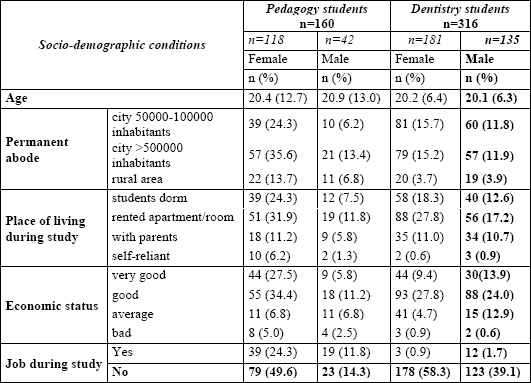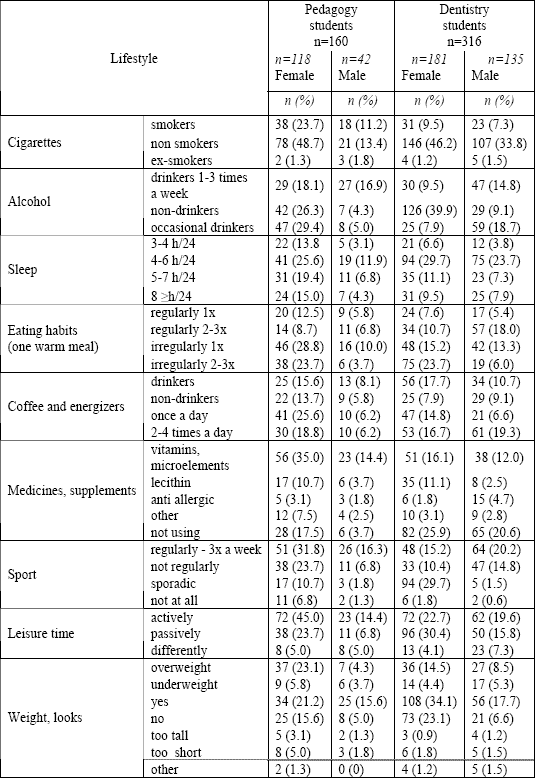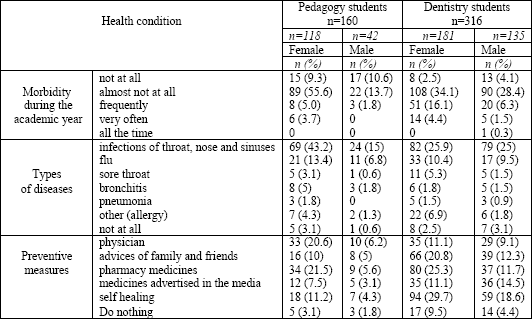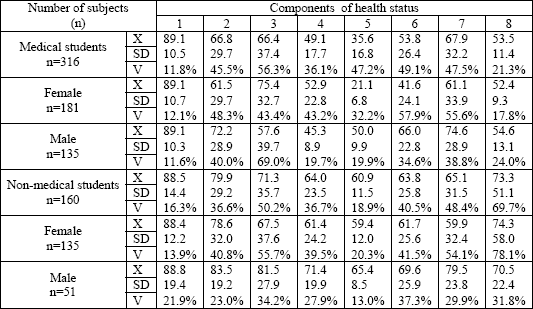Respiratory tract infections are the most frequent diseases diagnosed among students. It is estimated that respiratory infections in young students may occur 2-6 times a year. Most often these are uncomplicated infections of upper airways, which make around 25 million Americans report to the doctor every year. They cause nearly 20-22m days of work and school absenteeism per year each (1). Epidemiological data suggest that the most common pathogens involved are viruses. This finding is consistent with the data of the British Thoracic Society concerning the treatment of pneumonia in children. Authors examined the etiology of lower respiratory tract infections and stated that isolated viral infections are responsible for 14-53% of all infections, mixed etiology was found in 8-40% of infections and the etiological factor could not be isolated in 20-60% of cases (2). Therefore, it is possible that viruses cause up to 75% of all lower respiratory tract infections, where identification of the causative agent has been possible. If upper respiratory airways infections are included, viruses may be responsible for up to 90% of infections. There may be many possible infectious agents among the students. The number of infections is directly proportional to the number of students studying together in one group, living together in the dorm, etc.
One can assume that the main source of infections among students is the change of the so called “health area”. It consists of the following elements: biological, environmental, lifestyle, and healthcare factors. Our health is influenced in 5-15% by genetic factors, in 25-35% by physical and environmental factors, and in 50% by our lifestyle (3). The latter includes all the decisions and behaviors concerning our health which are influenced by our will. Important elements having influence on our health are individual behavior and social behavior. Lifestyle includes diet, physical activity, and hygiene as well.
The aim of the present study was to examine respiratory-related infection morbidity in among medical and nonmedical students as well as their quality of life regarding physical, mental social and environmental dimensions. The influence of socio-demographic factors upon the subjective assessment of quality of life, respiratory morbidity, and the duration of infection on students’ quality of life was also evaluated.
The study was approved by the Ethics Committee of the Pomeranian Medical University in Szczecin, Poland. Informed consent to the survey procedures was obtained from all participants in the study.
A total of 476 students were enrolled into the study (316 dentistry and 150 pedagogy students) of the first and third year in the Pomeranian Medical University in Szczecin and Zielona Góra University, Poland. Self evaluation of health status was performed using modified and shortened SF-36 questionnaire (Short Form 36 Health Status Questionnaire). SF-36 is a worldwide used tool of self evaluation of the health status in general population surveys and health policy evaluations (4-5). Health status is assessed using physical and mental components in eight dimensions:
1. physical functioning
2. role limitations due to physical health
3. role limitations due to emotional problems
4. energy/fatigue
5. social functioning
6. emotional well being
7. pain
8. general health
Answers were evaluated using a 100 point scale (max 100, min 0 points). Consecutive components of self evaluation are the sum of points to answers forming the studied component divided by the number of questions forming the component. Information concerning the respiratory tract infections type and frequency, lifestyle and socio-demographic conditions of evaluated subjects was collected as well. Data were categorized and evaluated statistically, first using the descriptive statistical methods, such as means ±SD and variability index (V), and then multiple analyses of variance. Significance was accepted at P
Data concerning socio-demographic conditions (place of living, economic status, etc.) of the surveyed students are presented in Table 1. Most of the subjects studied outside their permanent place of living, staying in rented rooms/apartments or dorms. Medical students (101 persons) rented their place of accommodation as singles in 36%, together with one mate in 21%, or with two mates in 18% of cases. Students of non-medical faculties preferred living as singles in rented rooms/apartments less frequently (24%).
| Table 1. Socio-demographic conditions of the subjects studied. |
 |
The majority of students came from full families (99.8%) in which both parents worked (98.9%). Most of students have both parents with college (64.3%), unfinished college (11.8%), or high school (23.7%) education. Female students more often than male students came from families of a higher social status (higher education of parents) (P<0.05).
Lifestyle, everyday habits associated with regular diet, physical activity, and the use of stimulants are shown in Table 2. 54 (17%) of the medical students smoked tobacco, 30 (9.5%) drank alcohol, and 182 (57.5%) drank coffee. Among the non-medical students, the percentage of smokers was higher, as it amounted to 29%. Overall, smokers constituted 19% of the group studied, out of which 13% were female students. Most of coffee drinkers had usually 2 glasses per day, while around 30% of the students had more than that. Consumption of energizers revealed a similar pattern; being in both groups of students around 24-28%. Most of the students have irregular diet. In both studied groups, regular meals were more common among students living together with their families. 21.8% of students indicated that they were not satisfied with their appearance due to overweight. There was a difference in the incidence of overweight among students of medicine and pedagogy. Comparison of the data showed differences between both groups of students in their emotional relation to physical activity (Table 2).
| Table 2. Lifestyle descriptive features of all surveyed subjects. |
 |
The results concerning the looks are worth being pointing out. Among 104 students (21.8%), overweight was the main reason of dissatisfaction with the physical appearance. A difference between the incidence of overweight between medical and non-medical students was noticed, which is consistent with the results concerning the physical activity. Similar differences were observed regarding the emotional attitude to physical training. Female pedagogy students more often declared their positive attitude to physical exercise compared with female medical students, out of which only 16.0% declare positive and 19.6% moderate or passive attitude to physical training. The results clearly indicate that students of both faculties spent little time actively during the week. Every fifteenth female student of medicine did not have any physical activity in her spare time. Pedagogy students more often involved themselves in physical activity than medical students. Most often cycling, aerobics, dancing and swimming were indicated as favorite sports. Overall, around 136 students (23%) have no sportive activity at all. Usually, lack of time and financial problems were indicated as the reasons.
The results concerning the frequency of respiratory tract infections are summarized in Table 3. From all surveyed subjects, only 48 (9.4%) of students did not suffer from any illness during the academic year. Medical students living in rented rooms/apartments or dorms had a higher incidence of diseases. Rather low percentage of students seeks medical advice (15.7%) and around 33% of them treat themselves using advice family members (22%), pharmacist (30%), or advertized medicines (17%). A higher percentage of medical students not seeking advice from the physician or pharmacist is a result of the fact that at least one family member is a doctor. Two hundred fifty two students (55%) declared a high risk of stress in their everyday life, while 94 (19.8%) indicated a moderate risk. A heavy workload of academic subjects was most often quoted as a reason for stress by both groups of students.
| Table 3. Morbidity of respiratory tract diseases for all studied subjects. |
 |
SF-36 test analysis
SF-36 questionnaire was used to assess the health status in regard to respiratory tract infections among medical students and to compare the results with those obtained from non-medical students. The survey was purposefully conducted before the classes ended and before the examination period to allow the students to compare their health condition from the beginning of the academic year with that at the end of it and to allow them to assess the influence respiratory tract infections might have had on their health status. It was carried out two weeks before the end of the classes and the beginning of examination period (Table 4 and Table 5). Using an analysis of variance, significant differences were found between the medical and non-medical students in their self-assessment of the health status.
| Table 4. Descriptive statistics concerning the health status assessed with SF-36 questionnaire. |
 |
| See Material and Methods for the numbering of the SF-36 components of health status. V – variability index. |
| Table 5. The intergroup differences in the SF-36 components of health status. |
 |
| See Material and Methods for the numbering of the SF-36 components of health status. |
1. ‘Physical functioning’ component
The mean value for this component was similar for both faculties and was around 89 (with 100 being the maximum). There were no significant differences in physical functioning between the male and female medicine or pedagogy students (Table 4).
2. ‘Physical health’ component
Physical activity of the medical students was lower than that of the pedagogy students. There was a high variability found in the studied group with regard to physical activity in general as well as in relation to sex, the faculty studied, etc. Females were characterized by lower physical activity than males, a finding confirmed by previous analyses. Medical students showed a significantly lower physical activity compared with pedagogy students (Table 5).
3. ‘Emotional problems’ component
The values of emotional problems were different depending on the faculty and sex. The male medical students showed much lower values comparing with the female counterparts. The situation was reversed in the pedagogy students (Table 4). There was a significant difference between the students of both faculties (Table 5).
4. ‘Energy/fatigue’ component
Medical students, in general, had lower values of energy/fatigue variable compared with pedagogy students. Despite a high variability index for this variable (Table 4), the values for medical students differed significantly from those of non-medical ones (Table 5).
5. ‘Emotional well being’ component
Higher values of this variable were observed among male than female students of both faculties (Table 4). Medical students showed significantly lower values of emotional well being values compared with non-medical students (Table 5).
6. ‘Social functioning’ component
There were lower values of the social functioning component found for the female than male students in regard to both faculties. There was a high variability of this component in all studied subgroups; the greatest being in case of female medical students (Table 5).
7. ‘Pain’ component
Male students had higher mean values of this variable. There were no differences concerning the pain component with respect to the faculty studied (Table 4).
8. ‘General health’ component
The mean values concerning the general health component were comparable between both genders. General health values were significantly different between the students of the two faculties (P=0.05) (Table 5).
Respiratory tract infections are most often indicated by the students as ailments disorganizing their everyday life and their studies. Upper respiratory infections are most often caused by viruses (in 95% of cases). Sneezing, sore throat, cough, and sometimes fever are among the most common symptoms of this disease-often called „common cold”. It is the impairment of immunity that initializes the ‘common cold’. Common cold is widespread among students and easy to treat but, unfortunately, often neglected, which causes complications, such as acute sinusitis, angina, bronchitis or pneumonia (6).
Our results show that around 40% of students treated themselves without medical advice. Students very often neglect their infections, especially those concerning upper airways. When the lack of positive pro-health behaviors such as physical activity, proper diet, stress management, weight maintenance, or sleep are added to that, a low self-evaluation of health among students (60.8 points out of 100 possible) is explicable. In the current study, most students declared dissatisfaction concerning their health. Students from different faculties were compared and the results indicate that the self-evaluation of health status depends on the kind of study. However, irrespective of the faculty of study, the energy potential and tiredness component of the self-evaluation was the lowest. A large group of the students surveyed pointed to a moderate or high stress risk. The stressful situations cannot be completely eliminated, but a lot of them can be avoided by a change in the lifestyle, which could improve immunity. Students should be able to use simple relaxation techniques that minimize the effect of stress. Physical activity should be a constant element of everyday routine, which prevents overweight and helps maintain good physical and psychological condition.
A large group of students spend their spare time passively; around 30% of surveyed subjects do not have any sports activity. Similar results were obtained by Kowalski (7) and Piotrowska et al (8) among the Faculty of Nursery students of the Gdansk Medical University and Warsaw Medical University. In the group surveyed, especially among medical students, it was clear that the character of education influences the efficiency of dealing with infections of the respiratory tract. This finding is in accord with that of Katz (9) regarding the influence of education and the level of knowledge on the results of self-care in other diseases. Medical students could taker better care of themselves due to the knowledge of functioning of the respiratory tract, of etiology, pharmacology, or due just to having a doctor in the family. Similar results were obtained by Sierakowska et al (10), who showed that the level education and interest in the subject influence the course of disease and help in recovery. Our results confirm that the quality of life of students with respiratory tract infections depends not only on the disease dynamics, but also on the ability to deal with problems brought about by the disease. Post-recovery rehabilitation seems to be a crucial element in regaining the immunity to upper airways infections. The methods of such rehabilitation include proper diet, rest, and herbs preventing the relapse of infection. Most students tend to forget it, although they indicate the use of vitamins and supplements. Deficit in physical activity negatively influences the subjective health and life assessment. Most students suffering from respiratory tract infections declare the importance of everyday physical activity. Such activity has a strong positive influence on physical and psychological status, increases self-esteem and reestablishes a positive relationship toward everyday activities; the findings confirmed in other similar studies (11). The survey performed in the present study seems to be an important source of knowledge about students’ well-being and their health problems.
In conclusion:
Frequent respiratory tract infections, lack of systematic physical activity, lack of sleep, and stress decrease the level of health self-evaluation among students.
Medical students cope much better with respiratory tract diseases, which shows that the kind of study, the level education, and interests influence the course and duration of disease.
Students living in rented apartments show higher morbidity and tend to consider their quality of life to be much worse when compared with students living with their families or in dormitories.
Conflicts of interest: No conflicts of interest were declared in relation to this article.
- Monto AS. Studies of the community and family: acute respiratory illness and infection. Epidemiol Rev 1994; 16: 351-373.
- Heikkinen T, Järvinen A. The common cold. Lancet 2003; 361: 51-59.
- Sadowski Z. Promocja zdrowia – szansa i konieczność. Nauki Społeczne i Medycyna 1994; 3-4, 15-17 (in Polish).
- Knapik A, Plinta E, Saulicz E, Kuszewski M. Physical activity and self-perceived health status based on SF-36 Questionnaire. Ann Univ Mariae Curie Sklodowska (Med) 2005; Vol. LX, Suppl XVI, 210: 433-436.
- Ware JJ, Sherbourne CD. The MOS 36-item short-form health survey (SF-36). I. Conceptual framework and item selection. Med Care 1992; 30: 473-483.
- Watelet JB, Van Cauwenberge P. Applied anatomy and physiology of the nose and paranasal sinuses. Allergy 1999; 54 Suppl 57: 14-25.
- Kowalski Z. Stan zdrowia i warunki higieniczne studentów Uniwersytetu Warszawskiego w świetle cyfr. „Zdrowie”, Warszawa 1998 (in Polish).
- Piotrkowska R, Ksiazek J, Wilczewska L. Heath behaviors of students of the Nursing Department at the Medical University of Gdansk. Ann Univ Mariae Curie Sklodowska (Med) 2005; Vol. LX, Suppl XVI, 416: 357-360.
- Katz PP. Education and self-care activities among persons with rheumatoid arthritis. Soc Sci Med 1998; 46: 1057-1066.
- Sierakowska M, Matys A, Kosior A et al. Evaluation of quality of life of patients with rheumatoid arthritis. Reumatologia 2006; 6: 298–303.
- De Walden-Galuszko K, Majkowicz M. Badanie jakości życia w medycynie. Gazeta Lekarska 1997; 4: 40 (Article in Polish).